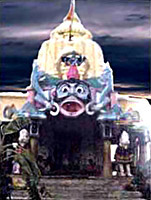 The temple of the Goddess Dhamrai is at Dhamra a small coastal town-ship in Orissa, where the river Dhamra adjoins the Bay of Bengal. Dhamra is about 60 Kms from Balasore in the eastern direction. Chandbali in the West, Basudebpur in the North, Kalibhanjadia in the South and Bay of Bengal in the East surround the place.
The temple of the Goddess Dhamrai is at Dhamra a small coastal town-ship in Orissa, where the river Dhamra adjoins the Bay of Bengal. Dhamra is about 60 Kms from Balasore in the eastern direction. Chandbali in the West, Basudebpur in the North, Kalibhanjadia in the South and Bay of Bengal in the East surround the place.
Legends:
There are a number of folk tales and legends concerning the deity and the temple. According to one of the historical legends, one merchant namely Dhaneswar who often traded with the Singhalies (Sri Lanka) had brought a deity namely "Pashana Mangala" from Sri Lanka and had established the same at Dhamara on his way back home. The deity later came to be known as Maa Dhamarai.
According to one of the folktales Maa Dhamrai had five sisters and was residing at a place called "Satabhaya". Her five sisters were carnivorous in contrast to the purely vegetarian Maa Dhamrai. This outraged her sisters and pushed her deep in to the sea. Floating on the water Maa Dhamarai came towards Chandinipala and is believed to have been caught in the fishing net of one Sanatana Dalai and Bulei Behera who had rescued her and started worshiping keeping her in their house. Later on it is believed that on the same night the queen of the then King of Kanika, Sailendra Narayan Bhanjadeo saw a dream where in Maa Dhamarai ordered her to build a temple.
Dhamrai Temple built by the then king Sailendra Narayan Bhanjadeo by the year 1953 was destroyed and the remains were washed away. During that period the people worshiped the deity keeping her within a thatched roof house.
It was around the year 1980 when some local influential persons seriously thought about constructing a temple for the deity and to regularly organize the rites and rituals related with the customs and traditions of Maa Dhamarai that included Makara Mela etc. However, though a committee had been formed and the foundation stone for the construction of the temple had been laid but it took around 8 to 10 years to actually construct the temple. A re-elected committee presided by one Sri Nityananda Majhi was
responsible for the present day temple.





















